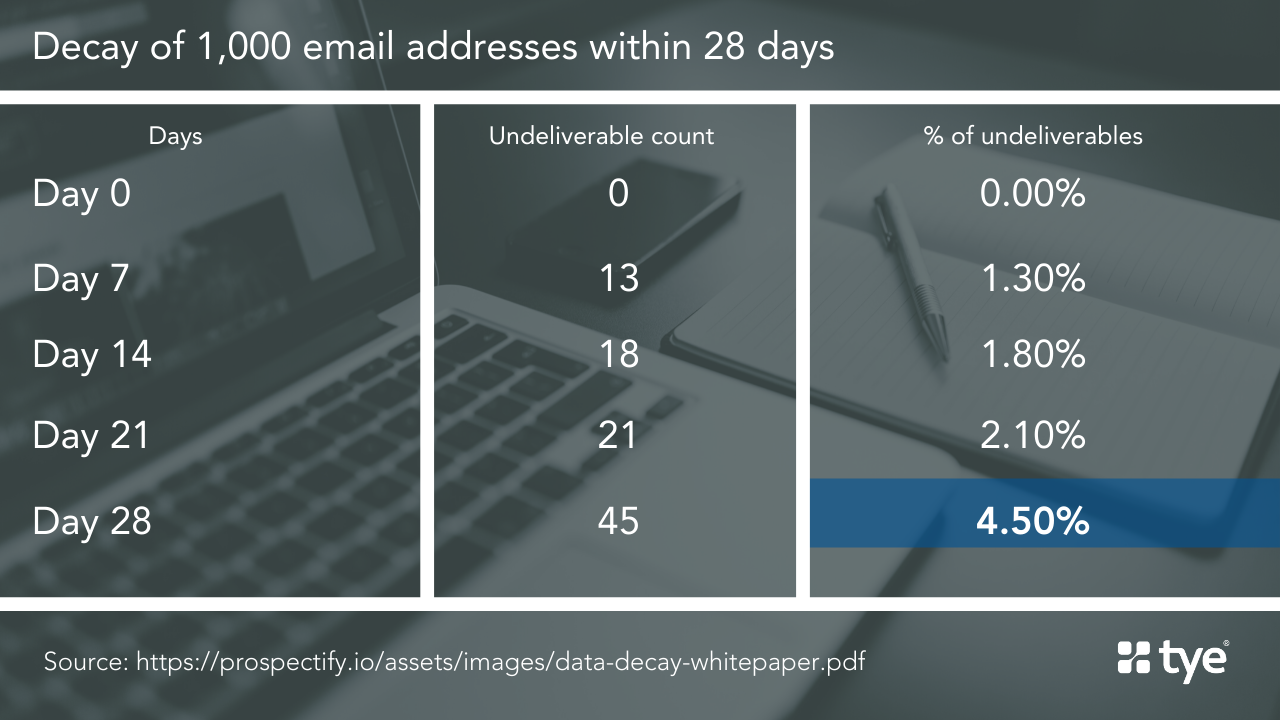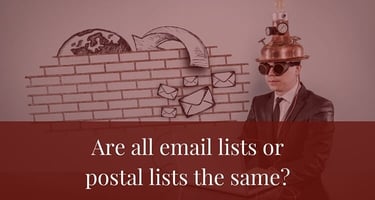It will come as no surprise to you that not all lists are equal. Quality, accuracy, availability,...
Email List Cleaning: Why and How to Properly Clean Your Lists
What is email list cleaning?
Email list cleaning is the process of updating your email contact list by removing any and all subscribers who have not opened any of your emails in a certain period of time, usually 6 months. This could be contacts that are no longer engaging with your emails or dated email addresses that are no longer active. Their emails could be causing your bounce rates to be high, your emails could be blocked or might have become spam traps.
Cleaning your email list improves deliverability,
open and click rates, and saves you money!

The Benefits of Email List Cleaning
In the ever-evolving landscape of digital marketing, email remains a powerful tool for businesses to connect with their audience. However, maintaining a clean and healthy email list is crucial to maximize the effectiveness of your email campaigns.
Better Sender Reputation -
Your sender reputation is a key factor that ISPs use to determine whether your emails should be delivered to the inbox or diverted to the spam folder. A poor sender reputation can have long-term negative effects on your email deliverability. Regularly cleaning your email list helps you maintain a positive sender reputation by reducing the chances of your emails being marked as spam or generating high bounce rates. By preserving your sender reputation, you ensure that your future email campaigns have a higher chance of reaching your subscribers' inboxes.
Lower Bounce Rates -
Another benefit of cleaning your is a lower bounce rate. Bounces are caused by undeliverable email addresses on your list. Typically, this is because of an email address change, a full inbox, a fake email address or a technical error. Too many bounces have the same effect as spam complaints: they hurt your sender reputation which results in more of your emails ending up in spam folders. If you clean your email list, the number of bounces will go down, meaning you will get a better reputation and so more of your emails will end up in inboxes.
Fewer Spam Complaints -
Cleaning your email list reduces the number of spam complaints. Spam complains are when a subscriber marks your email as spam. Often subscribers do this because they don’t remember signing up, or they get fed up of seeing your emails in their inbox – but feel bad about unsubscribing! The problem is that email providers keep a record of spam complaints. If you get a lot, they’ll start sending your emails straight to the spam folder or promotions tab. And not just for the people who reported you – they will send your emails to the spam folder for everyone you send email to. This means people who actually want to read your emails may stop seeing your emails in their inbox.
If you regularly clean your email list the likelihood of getting spam complaints is much lower. Fewer spam complaints means you will have a better sender reputation. This means more of your emails will reach subscribers’ inboxes, rather than ending up in spam.
Increase Email Deliverability -
When it comes to email marketing, deliverability is paramount. Sending emails to outdated or incorrect email addresses, spam traps, or inactive accounts can significantly harm your sender reputation. Internet service providers (ISPs) closely monitor engagement metrics like bounce rates, spam complaints, and unsubscribe rates to determine the quality of your emails.
By regularly cleaning your email list, you can improve your deliverability and increase the chances of your emails reaching the intended recipients' inbox. A clean list also leads to higher open rates, as you are targeting engaged and interested subscribers.
Increase Engagement -
A clean email list consists of subscribers who actively engage with your content. When you remove the inactive or uninterested subscribers, you create a more focused audience. This means your emails are more likely to resonate with the recipients, leading to higher engagement rates. When subscribers are genuinely interested in your content, they are more likely to click on links, make purchases, and take desired actions. Improving engagement and conversion rates can directly impact your bottom line and overall ROI.
What are the Risks of Not Cleaning Your Email List?
Maintaining an active and engaged subscriber base is crucial for the success of your email marketing campaigns. However, over time, subscribers may become inactive, leading to decreased open rates, engagement, and ultimately, the effectiveness of your email campaigns.
Data cleaning is not just a one-time activity. To maintain a clean email list, you need to repeatedly clean out the old data. The chart below shows how quickly data can decay and become undeliverable. It’s important to clean out those ‘bad’ contacts before they start to affect your deliverability.

5 Simple Email List Cleaning Tactics
Maintaining a clean and healthy email list is vital for the success of your email marketing campaigns. Regularly cleaning your email list helps improve deliverability, engagement rates, and overall campaign performance. Here we outline five essential steps to effectively clean your email list and ensure you are targeting an engaged and interested audience.
1 - Review and Segment Your Email List
Start by reviewing your email list to identify inactive or unengaged subscribers. Look for those who haven't opened or clicked on your emails in a significant period, such as six months or more. Once you've identified these subscribers, consider segmenting them into separate categories, such as "inactive," "unengaged," or "prospects." This segmentation will help you tailor your future email campaigns and messaging more effectively.
2 - Validate and Remove Invalid Email Addresses
Invalid or outdated email addresses can lead to high bounce rates and damage your sender reputation. Utilize an email validation service or software to verify the validity of email addresses in your list. These services can identify and remove email addresses with syntax errors, typos, or invalid domains. By eliminating invalid addresses, you increase the chances of your emails reaching the intended recipients and improve overall deliverability.
3 - Handle Bounces and Unsubscribes
Take prompt action on bounced emails and unsubscribe requests. Bounce management involves categorizing bounces as "hard" or "soft." Hard bounces occur when an email cannot be delivered permanently, typically due to non-existent or blocked email addresses. Soft bounces are temporary delivery failures, such as full inboxes or server issues. Remove hard bounces from your list immediately, as repeatedly sending emails to invalid addresses can harm your sender reputation. Monitor soft bounces and consider re-engagement campaigns to win back potentially interested subscribers.
4 - Re-engage with Inactive Subscribers
Engaging with inactive or unengaged subscribers through re-engagement campaigns can help identify those who are genuinely interested and want to remain on your list. Craft compelling and personalized emails that incentivize subscribers to take action, such as updating their preferences, completing surveys, or offering exclusive discounts. If subscribers do not respond or continue to show disinterest, consider removing them from your list to maintain list hygiene.
5 - Keep Cleaning Your List
Cleaning your email list should not be a one-time task but an ongoing process. Establish routine list hygiene practices to ensure your list remains clean and up-to-date. Regularly monitor engagement metrics, such as open rates, click-through rates, and unsubscribe rates, to identify trends and take appropriate actions. Consider implementing a double opt-in process for new subscribers to confirm their interest, reducing the chances of invalid or disengaged addresses entering your list.
Wrapping It Up
Cleaning your email list will generate immediate positive results and even greater returns in the long term. A clean email list will result in higher open and click rates and a better return on your investment.
Remember: the success of your email marketing should not be measured by the number of subscribers you have on your list. Rather, it should be measured by the quality of the subscribers and the actions they take as a result of your email!





